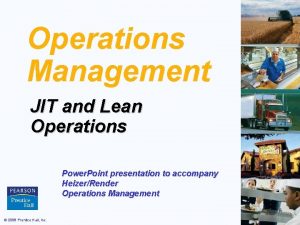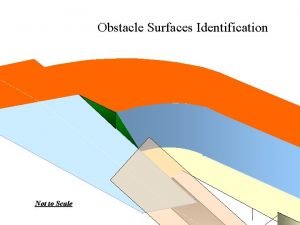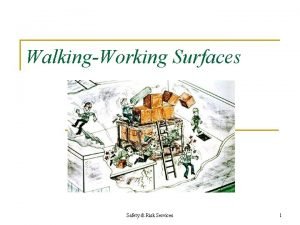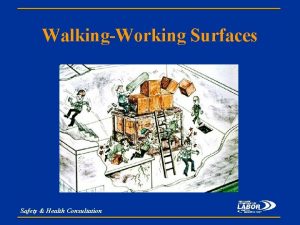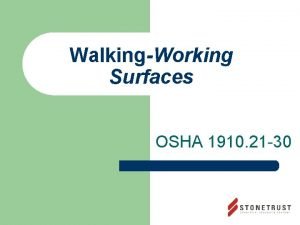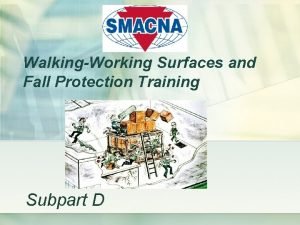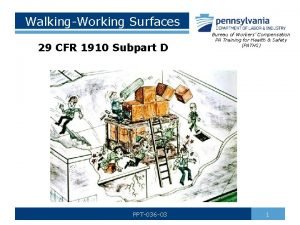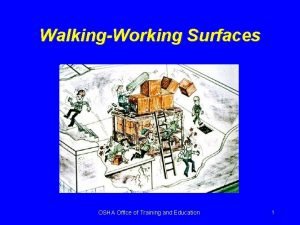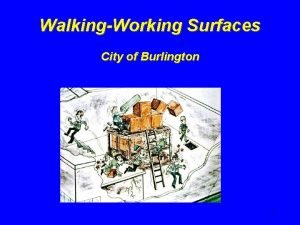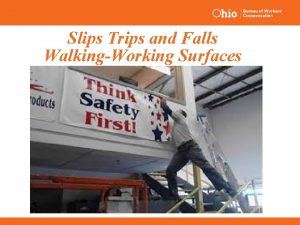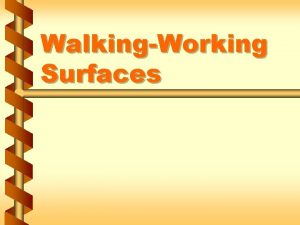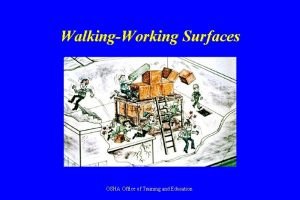Unit 15 4 WalkingWorking Surfaces HighPerformance Manufacturing Production

















- Slides: 17

Unit 15. 4 Walking-Working Surfaces High-Performance Manufacturing Production Technician

Introduction § Slips, trips and falls cause: o the majority of general industry accidents o 15 percent of all accidental deaths o more fatalities than all other causes but motor vehicles § OSHA’s standards for walking and working surfaces apply to all permanent places of employment, except where only domestic, mining, or agricultural work is performed

Housekeeping § Workplaces must be kept clean, orderly, and sanitary § Workroom floors must be maintained as clean and dry as possible

Aisles and Passageways § Keep clear and move obstructions that could create a hazard § Mark permanent aisles and passageways § Aisles must be sufficiently wide where mechanical handling equipment is used

Covers and Guardrails § Provide covers and/or guardrails to protect workers from the hazards of open pits, tanks, vats, ditches, and the like.

Floor Loading Protection § Load ratings must be marked on plates and be conspicuously posted § Do not exceed the load rating limit

Floor Opening § An opening measuring 12 inches or more in its least dimension in a floor, platform, pavement, or yard, through which persons may fall.

Open-Sided Floors and Platforms § Open-sided floors or platforms 4 feet or more above adjacent floor or ground level must be guarded by a standard railing (or equivalent) on all open sides, except where there is an entrance to a ramp, stairway, or fixed ladder § A toe board is required when, beneath the open sides: o persons can pass o there is moving machinery o there is equipment with which falling materials could create a hazard

Open-Sided Floors, Walkways, Platforms, and Runways § Regardless of height, a standard railing and toe board must be used to guard: o open-sided floors o walkways o platforms o runways • Above or adjacent to dangerous equipment, pickling or galvanizing tanks, degreasing units, and similar hazards

Stairways § Flights of stairs with four or more risers must have standard stair railings or handrails.

Fixed Industrial Stairs § Treads must be slip resistant with uniform rise height and tread width § Must be able to carry 5 times expected load; minimum of 1000 pounds § Minimum width of 22 inches Violation here – several steps bent and damaged

Portable Ladders § Ladders used to gain access to a roof or other area must extend at least 3 feet above the point of support § Withdraw defective ladders from service and tag or mark “Dangerous, Do Not Use” § Never use ladders in a horizontal position as scaffolds or work platforms § Never use metal ladders near electrical equipment

Ladder Angle Portable Rung and Cleat Ladders § Use at angle where the horizontal distance from the top support to the foot of the ladder is ¼ the working length of the ladder (length along ladder between the foot and top support).

Fixed Ladders § Permanently attached to a structure, building or equipment § Cages or wells required if longer than 20 ft. to a maximum unbroken length of 30 ft. § Ladder safety devices may be used on tower, water tank and chimney ladders over 20 ft. in unbroken length instead of cage protection

Scaffolding General Requirements § Must be capable of supporting four times the maximum intended load § Do not alter or move while in use § Protect workers on scaffolds from overhead hazards § If higher than 10 ft. , use guardrails, mid rails and toe boards § Use wire mesh between the toe board and guardrail if people work or pass underneath § Must be equipped with access ladder or equivalent

Summary § Slips, trips, and falls constitute the majority of general industry accidents § OSHA’s standards for walking and working surfaces include requirements for housekeeping, guarding floor and wall openings and holes, industrial stairs and ladders § Keeping working surfaces clean, dry, and uncluttered can prevent many workplace accidents

 Multimedia content production adalah
Multimedia content production adalah Manufacturing cost vs non manufacturing cost
Manufacturing cost vs non manufacturing cost Job costing vs. process costing
Job costing vs. process costing Manufacturing cost vs non manufacturing cost
Manufacturing cost vs non manufacturing cost Manufacturing cost vs non manufacturing cost
Manufacturing cost vs non manufacturing cost Additively
Additively эътиборингиз учун раҳмат
эътиборингиз учун раҳмат Example of production plan
Example of production plan Aster cherlapally manufacturing unit
Aster cherlapally manufacturing unit Unit 10, unit 10 review tests, unit 10 general test
Unit 10, unit 10 review tests, unit 10 general test Walking on slippery surfaces
Walking on slippery surfaces Square pyramid sides
Square pyramid sides Subdivision surfaces in character animation
Subdivision surfaces in character animation Statistical surfaces can be or
Statistical surfaces can be or Pinhole camera reflection
Pinhole camera reflection Human heart border
Human heart border Obstacle identification surface icao
Obstacle identification surface icao Interpenetration drawing
Interpenetration drawing






